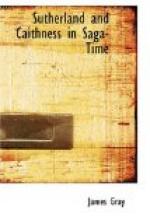Malcolm next defeated another rising by Somarled, who was killed in 1164, by treachery or surprise, in a skirmish at Renfrew,[28] and was not Somarled the freeman, who is said in the Orkneyinga Saga to have been slain by Sweyn in the Isles, in his pursuit and defeat of Gilli Odran in the Myrkfjord about seven years earlier.[29]
Then King Malcolm, after a short but brilliant reign, died in his 24th year. He was succeeded by his brother William the Lion, who was forthwith crowned at Scone on Christmas Eve 1165 in his twenty-second year.
We may now try to state how things stood in the north at the date of his accession. Soon after this time his grandfather’s friend, the first Freskyn, died between 1166 and 1171, and was succeeded by his son William MacFrisgyn, whose son Hugo would then be quite young. Harold Maddadson had in 1165 been for twenty-six years Earl of Caithness, and Jarl of Orkney and Shetland for nineteen years jointly with Ragnvald, and for seven years sole jarl of those islands.[30] He had probably put away his first wife Afreka of Fife about 1165, but he afterwards lived with Gormflaith, the daughter of Malcolm MacHeth from a date which cannot be fixed with certainty. Led by her, it is said, Harold was openly hostile to the Scottish king, of whom, however, he held the earldom of Caithness, which at that time included not only the parishes of Creich, Dornoch, Rogart, Kilmalie or Golspie, Clyne, Loth, and most of Kildonan and of Lairg, then called by the Norse Sudrland, but also the districts of Strathnavern, Eddrachilles, and Durness (where Mackay refugees had not yet permanently settled) as well as Ness, which is now known as the County of Caithness.




